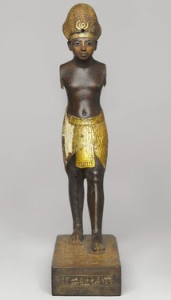Part 1:




Amunhotep III is made to be seen as an aging man due to the sagging cheeks. The medium of this artwork is wood, gold leaf (seen on the hat and kilt), glass and pigment. The eyes are outlined in a dark grayish-purple color as the eyebrows are outlined with a blackish-purple color. His shoulders are straight and the arms seem to be either cut or never made. His crown is gold and has a lot of definition and texture with a black square and a gold circlular pattern around it. Amunhotep III was made to stand on a wooden base with his left leg more forward than his right, almost like he is taking a step. With his status of King, although his legs were positioned one in front of the other, he was balanced. The kilt has straight vertical lines in the back and different line patterns in the front. In addition, the front of the kilt is shaped differently. In the middle it is in the shape of a rectangle with slits of a right triangle on the left and right sides. On the back, it is shaped almost as a straight line on the bottom back of the kilt. There is a noticeable metal loop on his neck as well. Amunhotep III has more color in his face, specifically a golden brown, than he does on his body, which is a little bit of adarker brown. The statue was not as tall as I expected, but it was three-dimensional and I was able to get a glimpse of all of its characteristics.


